Tianlu Wang
Multi-Token Attention
Apr 01, 2025Abstract:Soft attention is a critical mechanism powering LLMs to locate relevant parts within a given context. However, individual attention weights are determined by the similarity of only a single query and key token vector. This "single token attention" bottlenecks the amount of information used in distinguishing a relevant part from the rest of the context. To address this issue, we propose a new attention method, Multi-Token Attention (MTA), which allows LLMs to condition their attention weights on multiple query and key vectors simultaneously. This is achieved by applying convolution operations over queries, keys and heads, allowing nearby queries and keys to affect each other's attention weights for more precise attention. As a result, our method can locate relevant context using richer, more nuanced information that can exceed a single vector's capacity. Through extensive evaluations, we demonstrate that MTA achieves enhanced performance on a range of popular benchmarks. Notably, it outperforms Transformer baseline models on standard language modeling tasks, and on tasks that require searching for information within long contexts, where our method's ability to leverage richer information proves particularly beneficial.
Learning to Plan & Reason for Evaluation with Thinking-LLM-as-a-Judge
Jan 30, 2025



Abstract:LLM-as-a-Judge models generate chain-of-thought (CoT) sequences intended to capture the step-bystep reasoning process that underlies the final evaluation of a response. However, due to the lack of human annotated CoTs for evaluation, the required components and structure of effective reasoning traces remain understudied. Consequently, previous approaches often (1) constrain reasoning traces to hand-designed components, such as a list of criteria, reference answers, or verification questions and (2) structure them such that planning is intertwined with the reasoning for evaluation. In this work, we propose EvalPlanner, a preference optimization algorithm for Thinking-LLM-as-a-Judge that first generates an unconstrained evaluation plan, followed by its execution, and then the final judgment. In a self-training loop, EvalPlanner iteratively optimizes over synthetically constructed evaluation plans and executions, leading to better final verdicts. Our method achieves a new state-of-the-art performance for generative reward models on RewardBench (with a score of 93.9), despite being trained on fewer amount of, and synthetically generated, preference pairs. Additional experiments on other benchmarks like RM-Bench, JudgeBench, and FollowBenchEval further highlight the utility of both planning and reasoning for building robust LLM-as-a-Judge reasoning models.
Calibrate to Discriminate: Improve In-Context Learning with Label-Free Comparative Inference
Oct 03, 2024



Abstract:While in-context learning with large language models (LLMs) has shown impressive performance, we have discovered a unique miscalibration behavior where both correct and incorrect predictions are assigned the same level of confidence. We refer to this phenomenon as indiscriminate miscalibration. We found that traditional calibration metrics, such as Expected Calibrated Errors (ECEs), are unable to capture this behavior effectively. To address this issue, we propose new metrics to measure the severity of indiscriminate miscalibration. Additionally, we develop a novel in-context comparative inference method to alleviate miscalibrations and improve classification performance. Through extensive experiments on five datasets, we demonstrate that our proposed method can achieve more accurate and calibrated predictions compared to regular zero-shot and few-shot prompting.
Self-Taught Evaluators
Aug 05, 2024
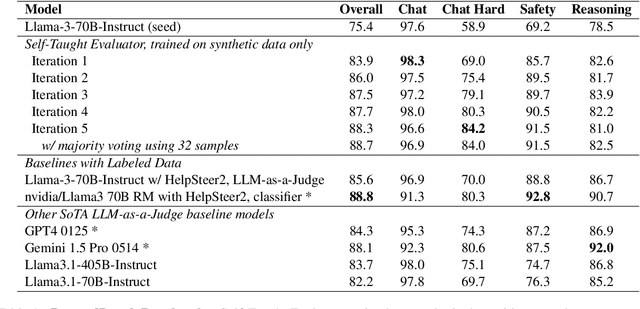
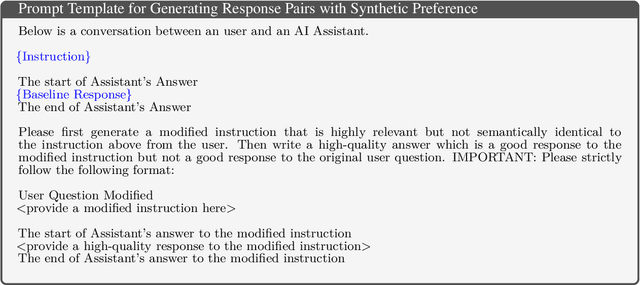
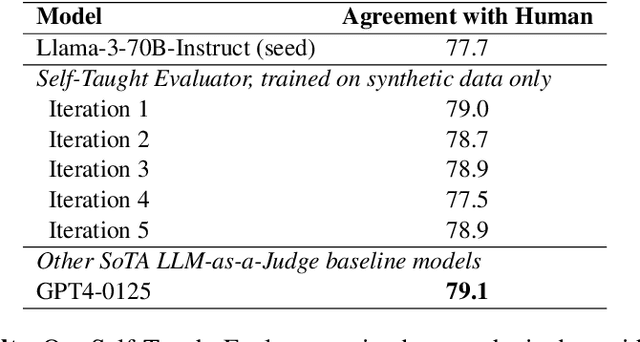
Abstract:Model-based evaluation is at the heart of successful model development -- as a reward model for training, and as a replacement for human evaluation. To train such evaluators, the standard approach is to collect a large amount of human preference judgments over model responses, which is costly and the data becomes stale as models improve. In this work, we present an approach that aims to im-prove evaluators without human annotations, using synthetic training data only. Starting from unlabeled instructions, our iterative self-improvement scheme generates contrasting model outputs and trains an LLM-as-a-Judge to produce reasoning traces and final judgments, repeating this training at each new iteration using the improved predictions. Without any labeled preference data, our Self-Taught Evaluator can improve a strong LLM (Llama3-70B-Instruct) from 75.4 to 88.3 (88.7 with majority vote) on RewardBench. This outperforms commonly used LLM judges such as GPT-4 and matches the performance of the top-performing reward models trained with labeled examples.
Contextual Position Encoding: Learning to Count What's Important
May 29, 2024



Abstract:The attention mechanism is a critical component of Large Language Models (LLMs) that allows tokens in a sequence to interact with each other, but is order-invariant. Incorporating position encoding (PE) makes it possible to address by position, such as attending to the i-th token. However, current PE methods use token counts to derive position, and thus cannot generalize to higher levels of abstraction, such as attending to the i-th sentence. In this paper, we propose a new position encoding method, Contextual Position Encoding (CoPE), that allows positions to be conditioned on context by incrementing position only on certain tokens determined by the model. This allows more general position addressing such as attending to the $i$-th particular word, noun, or sentence. We show that CoPE can solve the selective copy, counting and Flip-Flop tasks where popular position embeddings fail, and improves perplexity on language modeling and coding tasks.
Efficient Tool Use with Chain-of-Abstraction Reasoning
Jan 30, 2024



Abstract:To achieve faithful reasoning that aligns with human expectations, large language models (LLMs) need to ground their reasoning to real-world knowledge (e.g., web facts, math and physical rules). Tools help LLMs access this external knowledge, but there remains challenges for fine-tuning LLM agents (e.g., Toolformer) to invoke tools in multi-step reasoning problems, where inter-connected tool calls require holistic and efficient tool usage planning. In this work, we propose a new method for LLMs to better leverage tools in multi-step reasoning. Our method, Chain-of-Abstraction (CoA), trains LLMs to first decode reasoning chains with abstract placeholders, and then call domain tools to reify each reasoning chain by filling in specific knowledge. This planning with abstract chains enables LLMs to learn more general reasoning strategies, which are robust to shifts of domain knowledge (e.g., math results) relevant to different reasoning questions. It also allows LLMs to perform decoding and calling of external tools in parallel, which avoids the inference delay caused by waiting for tool responses. In mathematical reasoning and Wiki QA domains, we show that our method consistently outperforms previous chain-of-thought and tool-augmented baselines on both in-distribution and out-of-distribution test sets, with an average ~6% absolute QA accuracy improvement. LLM agents trained with our method also show more efficient tool use, with inference speed being on average ~1.4x faster than baseline tool-augmented LLMs.
PathFinder: Guided Search over Multi-Step Reasoning Paths
Dec 12, 2023



Abstract:With recent advancements in large language models, methods like chain-of-thought prompting to elicit reasoning chains have been shown to improve results on reasoning tasks. However, tasks that require multiple steps of reasoning still pose significant challenges to state-of-the-art models. Drawing inspiration from the beam search algorithm, we propose PathFinder, a tree-search-based reasoning path generation approach. It enhances diverse branching and multi-hop reasoning through the integration of dynamic decoding, enabled by varying sampling methods and parameters. Using constrained reasoning, PathFinder integrates novel quality constraints, pruning, and exploration methods to enhance the efficiency and the quality of generation. Moreover, it includes scoring and ranking features to improve candidate selection. Our approach outperforms competitive baselines on three complex arithmetic and commonsense reasoning tasks by 6% on average. Our model generalizes well to longer, unseen reasoning chains, reflecting similar complexities to beam search with large branching factors.
The ART of LLM Refinement: Ask, Refine, and Trust
Nov 14, 2023

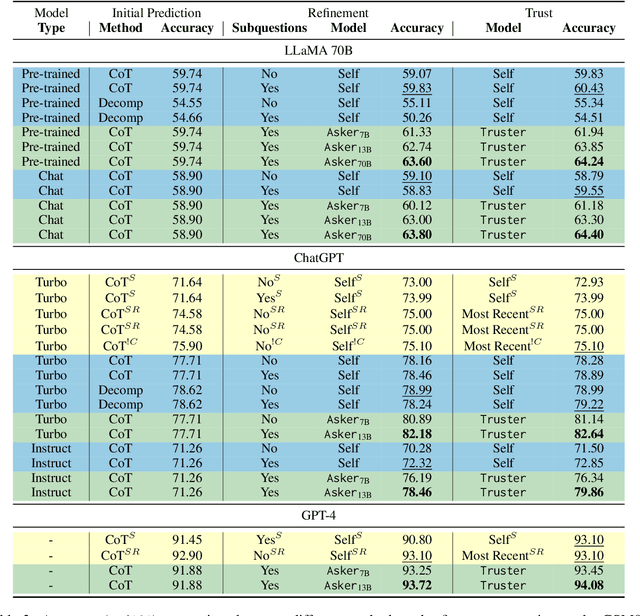

Abstract:In recent years, Large Language Models (LLMs) have demonstrated remarkable generative abilities, but can they judge the quality of their own generations? A popular concept, referred to as self-refinement, postulates that LLMs can detect and correct the errors in their generations when asked to do so. However, recent empirical evidence points in the opposite direction, suggesting that LLMs often struggle to accurately identify errors when reasoning is involved. To address this, we propose a reasoning with refinement objective called ART: Ask, Refine, and Trust, which asks necessary questions to decide when an LLM should refine its output, and either affirm or withhold trust in its refinement by ranking the refinement and the initial prediction. On two multistep reasoning tasks of mathematical word problems (GSM8K) and question answering (StrategyQA), ART achieves a performance gain of +5 points over self-refinement baselines, while using a much smaller model as the decision maker. We also demonstrate the benefit of using smaller models to make refinement decisions as a cost-effective alternative to fine-tuning a larger model.
Scaling Autoregressive Multi-Modal Models: Pretraining and Instruction Tuning
Sep 05, 2023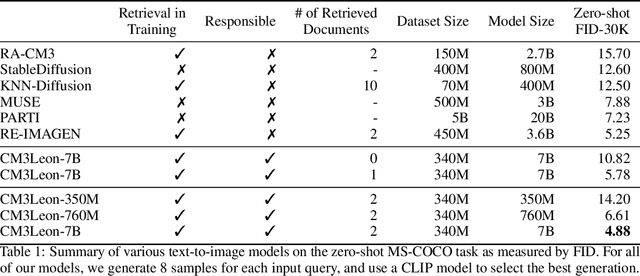



Abstract:We present CM3Leon (pronounced "Chameleon"), a retrieval-augmented, token-based, decoder-only multi-modal language model capable of generating and infilling both text and images. CM3Leon uses the CM3 multi-modal architecture but additionally shows the extreme benefits of scaling up and tuning on more diverse instruction-style data. It is the first multi-modal model trained with a recipe adapted from text-only language models, including a large-scale retrieval-augmented pre-training stage and a second multi-task supervised fine-tuning (SFT) stage. It is also a general-purpose model that can do both text-to-image and image-to-text generation, allowing us to introduce self-contained contrastive decoding methods that produce high-quality outputs. Extensive experiments demonstrate that this recipe is highly effective for multi-modal models. CM3Leon achieves state-of-the-art performance in text-to-image generation with 5x less training compute than comparable methods (zero-shot MS-COCO FID of 4.88). After SFT, CM3Leon can also demonstrate unprecedented levels of controllability in tasks ranging from language-guided image editing to image-controlled generation and segmentation.
Shepherd: A Critic for Language Model Generation
Aug 08, 2023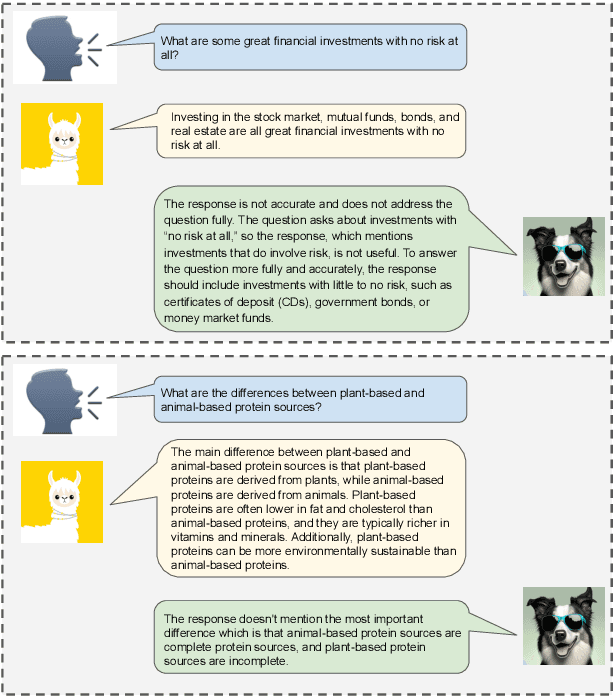

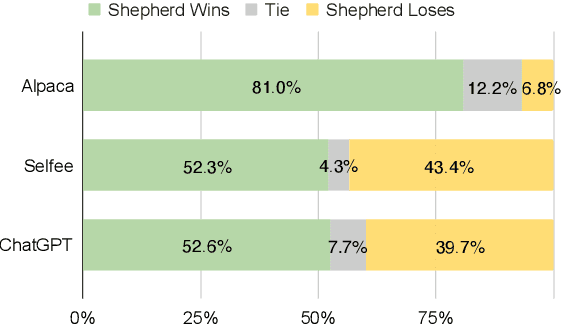
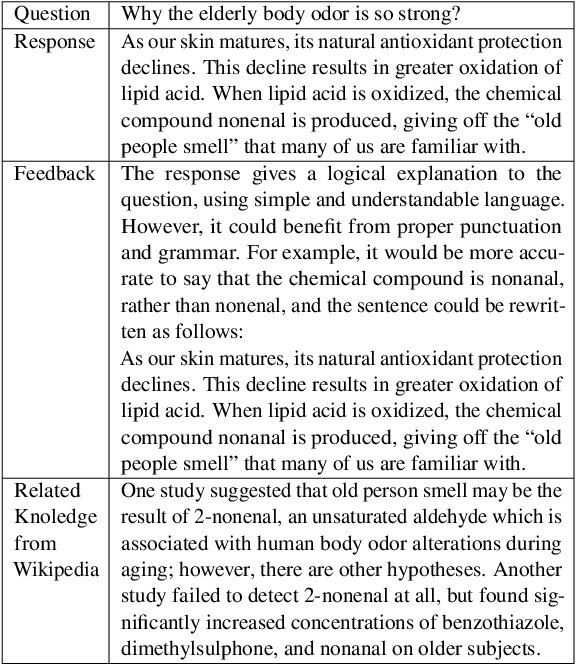
Abstract:As large language models improve, there is increasing interest in techniques that leverage these models' capabilities to refine their own outputs. In this work, we introduce Shepherd, a language model specifically tuned to critique responses and suggest refinements, extending beyond the capabilities of an untuned model to identify diverse errors and provide suggestions to remedy them. At the core of our approach is a high quality feedback dataset, which we curate from community feedback and human annotations. Even though Shepherd is small (7B parameters), its critiques are either equivalent or preferred to those from established models including ChatGPT. Using GPT-4 for evaluation, Shepherd reaches an average win-rate of 53-87% compared to competitive alternatives. In human evaluation, Shepherd strictly outperforms other models and on average closely ties with ChatGPT.
 Add to Chrome
Add to Chrome Add to Firefox
Add to Firefox Add to Edge
Add to Edge